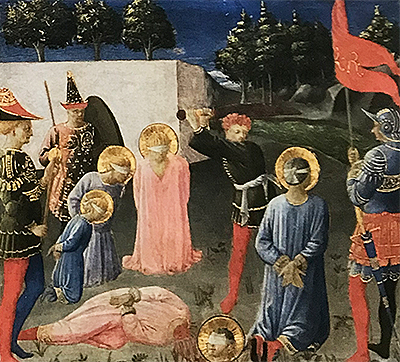Here we find the Six Episodes from the Lives of Saints Cosmas and Damian for the Annalena Altarpiece draw to a close with this powerful, impactful final fresco. All of these items were to be displayed alongside each other within a predella, sitting just below a main panel.
We see the extraordinary, terrifying sight of a beheaded figure lying on the floor, whilst others prepare for seemingly the same fate. Halos indicate their saintly status and the artist loved to use golden paint for those features in order to make them stand out as much as possible. A soldier stands to the right hand side with a large flag which symbolises the ruling powers, and perhaps therefore the misuse of power which is inflicted directly on the frightened individuals in the centre of the composition. There is an executioner with a long sword held menacingly over his shoulder as a further individual seems to be close to death. The architecture in this piece is simple, with just a small wall, perhaps suggesting that we are outside the perimeter of the city itself, with these figures being buried elsewhere for their perceived crimes. There is also an attractive row of trees to further set the scene as this butchering is carried out with quite some vigour.
Fra Angelico became a much loved artist who was well placed to complete many series of commissions for various religious churches and other institutions. That said, despite producing so much work across his career it is possible to reduce it down to a few highlights, with his most famous contributions including the likes of Annunciation, The Last Judgement and San Marco Altarpiece, with his band of highly skilled assistants often helping him out so that work could be completed more quickly, and new patrons then added as news of his achievements continued to spread. His assistants would be taught to work in a similar manner so that collaborative work would retain a good level of consistency.
Those interested in the work of this talented painter should also check out related artists such as Andrea del Verrocchio, Tintoretto and Annibale Carracci. A little later there was also the work of Artemisia Gentileschi who overcame considerable barriers due to her gender, but was still able to achieve great success within her own career. The studios of these artists would help to ensure that their stylistic methods would continue into other careers, with some of the assistants considered excellent artists in their own right, and some going on to become well known independently. Fra Angelico was no different in that regard, with Zanobi Strozzi helping him out reqularly and actually being a specialist in manuscript design himself.




